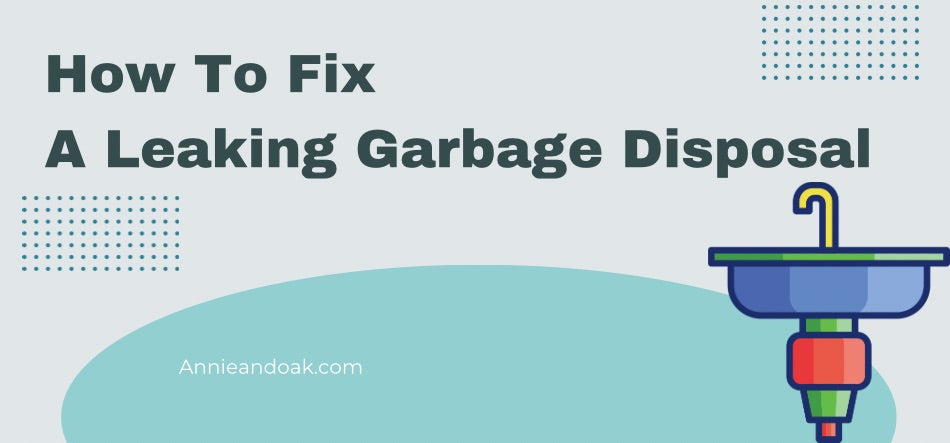
How To Fix A Leaking Garbage Disposal

How often do you hear about leaking garbage disposals? If you live in a home built before 1990, the chances are good that you've experienced this problem at some point.
In fact, according to the National Association of Home Builders (NAHB), nearly half of all new homes built today leak water into the basement.
Leaks happen because the sink and the disposal seal aren't tight enough. The result is water seeping through the drain pipe and dripping down the wall. This can cause damage to floors, walls, ceilings, and even furniture.
Leaky garbage disposals aren't dangerous, but they can be annoying. Fortunately, leaks can be fixed easily. So here's how to fix them.
Why Do Garbage Disposals Leak?
The most common reason for a leaking garbage disposal is improper installation. When installing your garbage disposal, make sure it fits properly in the sink.
It should sit flush against the side of the sink so there's no gap or space where water can escape.
Another possible source of the leakage is the connection from the sink to the disposal unit itself.
Make sure the rubber gasket around the opening is tightly sealed. You may need to tighten the screws holding the cover plate on top of the sink.
If you have an older house with a cast-iron sink, check to see if the drain hole has been blocked by rust. A rusty drain hole can prevent the disposal from working properly.
If you're not sure whether the leak is coming from the sink or the disposal, turn off the power to the garbage disposal and run cold water directly into the sink. If the leak stops, the problem is likely coming from the sink.
Fixing A Leaking Garbage Disposal

To repair a leaking garbage disposal, first shut off the power to the disposal unit to prevent an electric shock.
Next, you should always insert a sink stopper into the drain and mix a small amount of food coloring with water. Pour this onto the stopper to discover the location of the leak.
Now you know where the leak is coming from, you can begin your repairs. If your garbage disposal is leaking from the top, you'll need to reseal it and tighten up the flange.
To do this, detach the garbage disposal from the sink, remove the old gasket, and replace it with a new one. Then reattach the disposal to the sink.
If your leak is coming from the bottom, you'll need to loosen the bolts holding the sink to the countertop. Remove the sink, and inspect the area underneath the sink for any cracks or holes.
If you find anything, patch it up immediately. Once the crack or hole is repaired, reinstall the sink and tighten up the bolts.
If the side of your garbage disposal is leaking, you'll need to replace any worn gaskets and tighten your drain line connections.
To do this, unscrew the garbage disposal and pull out the disposal unit. Inspect the sides of the sink for any cracks and patch those areas if necessary.
Reinstall the disposal unit, and then screw it back into place. Finally, reconnect the plumbing lines and test the garbage disposal again.
If your leak is where the dishwasher hose joins the dishwasher inlet, you may need to tighten the screws inside the metal clamp. This can be done quickly with a screwdriver.
If the leak occurs on the side where the disposal joins the waste pipe, you'll need to loosen the screws and examine the rubber gasket in the pipe.
If it's worn, you may need to replace the gasket and tighten up the drainpipe screws.
If you still don't hear any running water after fixing the leak, you may need to call a plumber.
Replacing A Garbage Disposal
Remove the cover plate and unscrew any fasteners holding the disposal unit in place. Next, disconnect the electrical cord from the disposal and pull out the disposal unit.
Next, remove the old disposal unit and dispose of it safely. Finally, replace the disposal unit and reattach the electrical cord. Then, turn the power back on and test the system again.
Call a professional plumber if the leak still persists after replacing the disposal. Professional repairs can be expensive, but if you have limited repairs experience, it may be the safest option for you.
Tips For Preventing A Leaking Garbage Disposal
Keep your garbage disposal clean. That way, you'll reduce the likelihood of a clog forming inside the unit.
Also, don't put anything hard in the disposal, like metal utensils or large pieces of meat, which could jam up the mechanism and stop water flow.
In addition, avoid putting too much food waste in the disposal. For example, food scraps tend to attract bacteria and other contaminants, leading to clogs.
Also, don't use harsh chemicals such as bleach or ammonia when cleaning your garbage disposal. These substances can corrode the parts inside the disposal.
Finally, remember that a leaking garbage disposal doesn't pose a serious health risk. However, it can be very inconvenient. So, if you notice a leak, contact a professional immediately.
Do I Need a New Garbage Disposal?
Generally, you don't need a new garbage disposal unless it's damaged. But sometimes, a replacement is necessary.
If the disposal is broken or missing parts, you'll want to get a new one. Also, if the disposal doesn't work well, it might benefit from a tuneup.
A good rule of thumb: if the garbage disposal is more than five years old, it probably needs a tuneup.
Most causes of a leaking garbage disposal can be repaired easily, and unless there's severe damage to the unit, you won't need to install a new one.
Final Thoughts
Although a leaking garbage disposal isn't a threat to health, it's an annoyance - a big one. Thankfully, most of the causes of a leaky garbage disposal are simple to solve and will not require a replacement unit.
So if you're an experienced DIYer, you'll see that finding the leak and carrying out your own repairs doesn't have to be a challenge!






